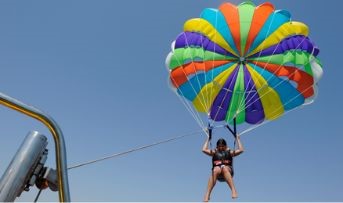Blog Details - Magma HDI

The complete guide for people trying parasailing for the first time 22nd November 2022
Adventure sports have always been the best option for people who call themselves adrenaline junkies. They give you the thrill that knocks out your everyday life's monotony. There are different types of adventure sports, like river rafting, paragliding, bungee jumping, trekking, rock climbing, skydiving, and much more.
In this blog, we'll discuss parasailing, a sport that has created a special bond with adventure enthusiasts. Parasailing is an adventure sport that gives you the joy of sailing in the air while your parachute is towed by a motorboat or jeep. If you plan to enjoy this activity on your next beach vacation, consider this blog for an enjoyable experience.
1. The weather is an essential factor:
The parasailing conditions need to be suitable, and the timing of the day has an effect. Usually, a clear sky and a less windy time are preferred, so most people plan their parasailing trip in the mornings.
2. Get well acquainted with the equipment:
Knowing your parasailing equipment and its functionalities is a must. Even if you cannot understand the mechanics of the equipment in detail, you should be aware of the purpose of the essential tools which will keep you safe. The life jacket is provided to keep you safe if you need to land in water during emergencies.
The body harness helps keep you seated and is joined to the ends of the tow bar. The harness aids in eliminating your discomfort and helping you maintain a balance during sudden movement shifts. And the tow bar is attached to a parachute to help you glide smoothly and land without any significant danger.
3. Get complete information about the restrictions:
To restrict the risks to the bare minimum, the parasailing institutes set certain limitations regarding the prospective client's age, height, and weight for parasailing. These restrictions are also influenced by certain factors, such as the wind level. Still, you must check in with the guide who will help you to avoid any threats to your health and life.
The minimum age limit for the riders is usually around sixteen to eighteen years, and the minimum weight in case there are multiple riders is supposed to be about 150 pounds. But these limitations vary, so check this with your parasailing guide.
4. Your outfit:
Swimming-appropriate outfits help since they are snug and would help if you land in water or experience waves. But anything comfortable is a must, and the bottoms should fit you well so that you are focused on the experience and not distracted by the discomfort caused by your outfit. These experiences are not everyday things, so you better eliminate all sorts of discomfort, stress, and distractions to make the moment count.
5. Research the company:
Read the online reviews about your parasailing company/institute and check their ratings. You must go to the right agency with all security measures intact, trained professionals, quality equipment, and SOPs to take care of their riders. Always ask all the questions to clear your doubts before going in.
6. Carefully listen to the instructions:
Before they put the parasailing gear on, the guide will give you all the information you need, even though you are riding solo or with multiple riders. They will tell you the landing postures, which part of the equipment will help you ride low, high, turn, etc. Always ensure to clarify your doubts before you begin.
That was the complete guide for people trying parasailing for the first time. As we discussed, while adventure sports allow you to experience the unforgettable, they also involve a certain level of danger to your life. Therefore, browsing personal accident insurance plans as a mitigation strategy for unpredictable circumstances is essential. Choose the one that suits you best before planning your adventure trip.
Click HERE to learn how you and your friends can get personal accident insurance plans.
Disclaimer: The information provided above is for illustrative purposes only. To get more details, please refer to policy wordings and prospectus before purchasing a policy.

